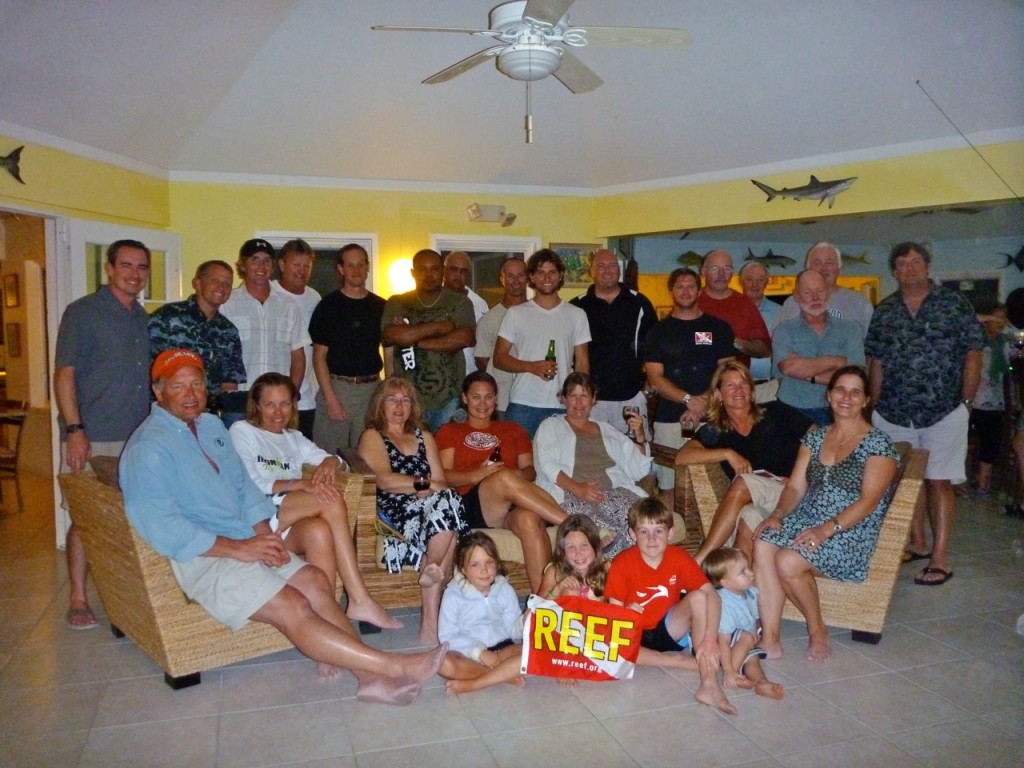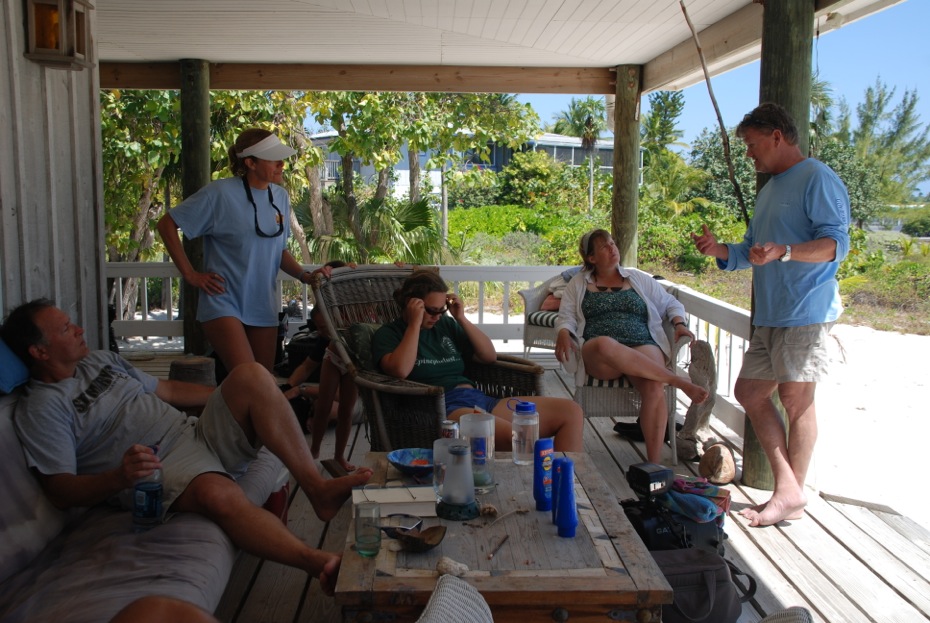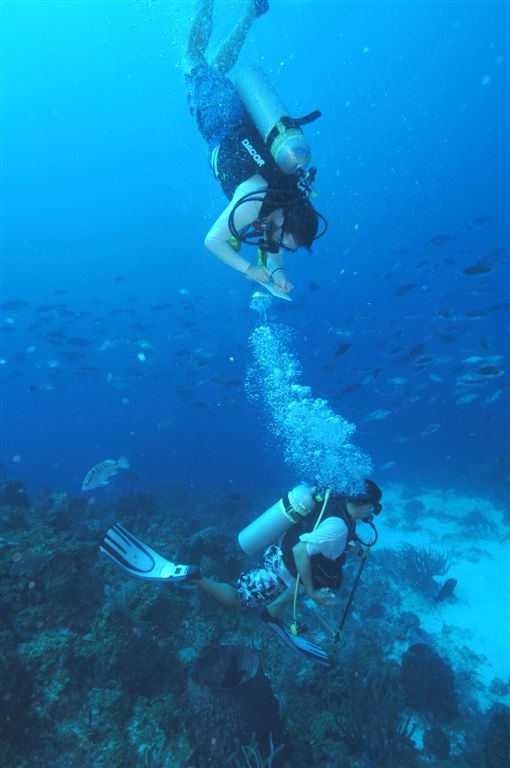As the winter full moon approaches, the Southern Cross Club on Little Cayman prepares for the annual arrival of the Grouper Moon Project team. Each year from late January to early February, scientists and volunteers of the Reef Environment Education Foundation (REEF) join staff from the Cayman Islands Department of the Environment (DOE) to document the last healthy, active and protected Nassau Grouper spawning site just off Little Cayman. The Southern Cross Club and others in the local community provide vital support to the team, recognizing that it takes an entire community to bring this historical and endangered species back from the brink of extinction.
In addition to documenting fish activity and population for valuable research data, the project also reaches out to local school children hoping to inspire them to join the conservation effort. It does this largely by streaming live video on the Internet from Little Cayman to local classrooms where children can see on a computer the work being done through the Grouper Moon Project. Two live webcasts are planned from underwater; one of them from the aggregation site where a scientist in scuba gear diving among the fish will show students what happens when Grouper spawn and why they are vulnerable at this time. He will also answer their questions about the mysterious and solitary fish that travels long distances to spawn at this site on Little Cayman. This year the webcasts are being streamed to classrooms in 10 schools on Grand Cayman, 3 schools on Cayman Brac, and for first time, the small school on Little Cayman.
“We’ve been expanding every year, adding more schools to the program because we get such good response,” says REEF educator Todd Bohannon, who with guidance from REEF scientists has developed the education curriculum. The webcasts lessons will be streamed from the aggregation site off the west coast of Little Cayman, from project headquarters at a house near the Southern Cross Club and from Bloody Bay Wall.

“The kids have an immediate connection to the lessons because it’s their history,” says Bohannon, who facilitates the webcasts between the scientists and the classrooms, fielding questions from the students. “They need to see the threat to the fish and these webcasts allow them to see it right in front of their eyes. We are giving them the tools they need to protect their environment and they are very enthusiastic, super smart and super excited.”
The hope is that by giving Caymanian kids a chance to see first hand what the scientists are doing to save the grouper, it will inspire them to continue the conservation work. Bohannon says the response from the children of Cayman Brac as been outstanding, and this year family evening events are planned.
“I can tell the Brac kids are talking to their families about the program because of their questions regarding fishing,” says Bohannon. “They get really excited, their reaction and comments are richer, and I like that.”
Although they’ve never seen the live feeds before, the students of the Little Cayman Education Service (LCES) School have always been aware of what happens on their island during the Grouper Moon.
“They know what’s going on in Little Cayman when we come in and infiltrate the island!”
says Bohannon. Last year Internet problems prevented a webcast in their classroom, so the Grouper Moon team made a personal visit to the classroom. “They loved it – it was great!”

Some of the live webcast lessons will be broadcasted from the porch at Peter Hillenbrand’s house near the Southern Cross Club. Hillenbrand, owner of the resort and a dedicated conservationist, is happy to have his house become “Grouper Moon central.” He enjoys being involved in the project and watching the marine scientists teach important lessons from his porch.
“The live broadcasts are one of the coolest learning tools I have ever seen,” he says. “It brings the Grouper Moon right into the class room, and there is nothing more important that educating our children about the world that surrounds them. There is not a better way to be amazed and learn other than being there yourself.”
Peter Hillenbrand and his team at the Southern Cross Club have been hosting the scientists and volunteers since the project began more than 12 years.
“We just take over the place – everyone is crashed out,” laughs a grateful Todd Bohannon, speaking for the entire Grouper Moon team. “This contribution is huge from a logistical point of view – Pete and his team always help out no matter what we need.”
“How do I prepare my house for the invasion? Ha! Well, I guess I try to make sure the sheets and towels are all clean, and my rum supply is abundant!” jokes Hillenbrand.
The good-natured camaraderie of the team enables and supports important conservation work being done. Nassau grouper has historically been one of the Caribbean’s most economically important fish, but intense harvesting during spawning aggregations, has placed them on the endangered list. REEF is a volunteer organization and DOE has a limited research budget, so the project depends on volunteers, donations, fundraising and grants. Supporting the study are; Disney Worldwide Conservation Fund, Lenfest Ocean Program of the Pew Charitable Trusts, the NOAA International Coral Reef Conservation Program, the J. Edward Mahoney Foundation, and PADI Project AWARE. The Grouper Moon Project also relies on help from the Southern Cross Club and Peter Hillenbrand, the Little Cayman Beach Resort, Reef Divers, Brac Reef Resort, Divetech and others in the Cayman community.

Grouper Moon Project leaders say ultimately the salvation of the Nassau grouper depends on everyone who cares, doing their part to save the species – then carrying the message and passion to others. This year a few classrooms in the U.S. are participating in the live webcasts, and the team includes a couple of educators from the Bahamas, which helps the whole Caribbean.
“It’s vital for the success of the Grouper Moon Project to get the community involved,” says Todd Bohannon. “To have it last into perpetuity, you need to get the kids involved and you need to have the backing of the community.”
Each video session will begin at 11:45 am and continue for about an hour on designated dates. For more information and daily updates on the Grouper Moon Project visit:
www.groupereducation.edublogs.org.
Webcast Schedule:
Friday, Feb 6 at 11:45 am
Monday, Feb 9, 11:45 am
Tues, Feb 10, 11:45 am
Wed, Feb 11, 11:45 am (Backup Date)
(Cayman Time – CST)
About the Southern Cross Club
The casually sophisticated Southern Cross Club Fish & Dive Resort is Little Cayman’s original resort. It features 14 beachfront bungalows complete with a top-rated, professional in-house diving and fishing operation. A unique blend of rusticity and elegance the resort is often described as “Barefoot Luxury”. Guests can expect friendly and diligent service, delicious food, inviting rooms with breath-taking views and a comfortable dive boat ― a few of the things that bring them back year after year. Little Cayman is renowned for its breath-taking and pristine coral reefs and spectacular dive adventures. The resort’s beach-based location also provides flats fisherman with access to Bonefish and Permit just minutes away.
For reservations or more information:
Telephone: 1 (800) 899-CLUB (2582)
Website: www.southerncrossclub.com
Facebook: www.facebook/SouthernCrossClub







